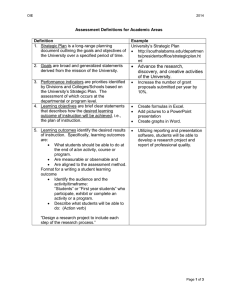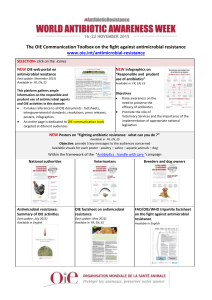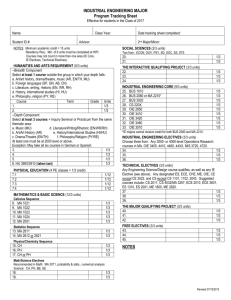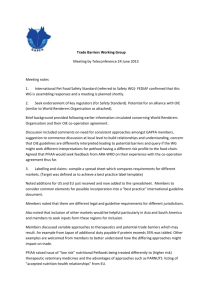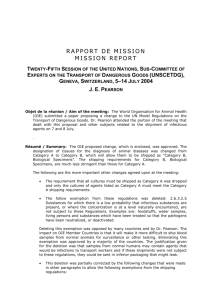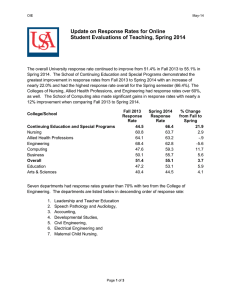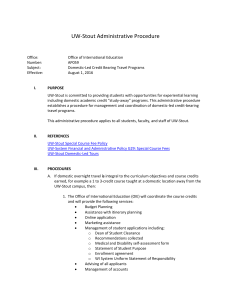A Guide to OIE Certified Laboratory Twinning Projects Introduction to Twinning
advertisement
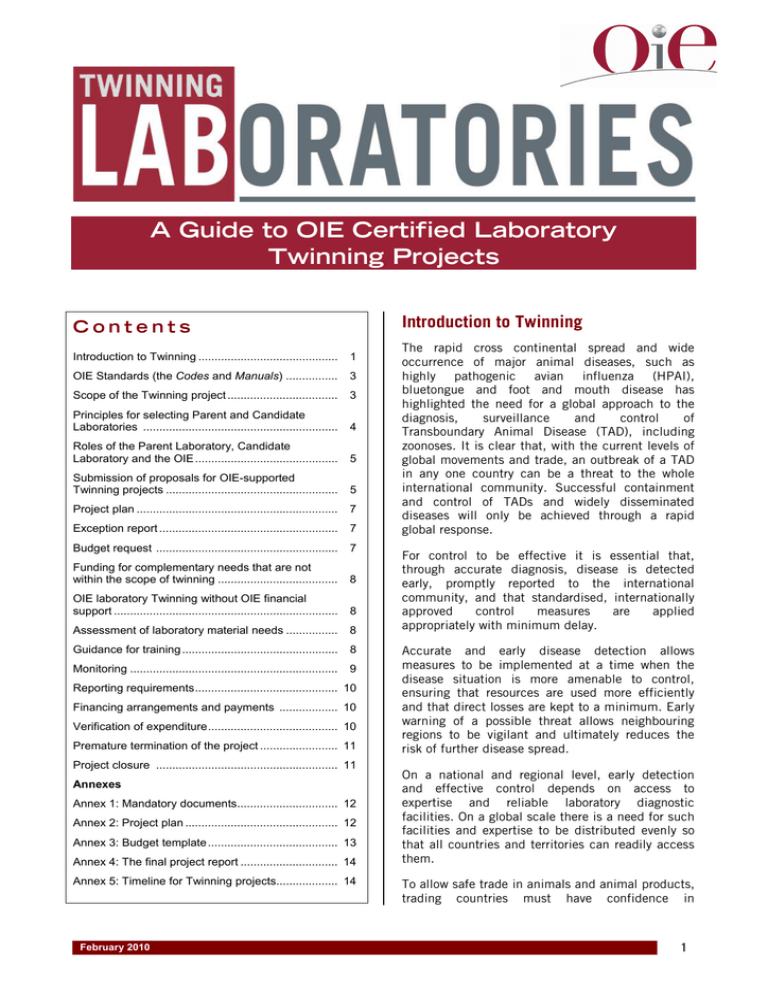
A Guide to OIE Certified Laboratory Twinning Projects Introduction to Twinning Contents Introduction to Twinning ........................................... 1 OIE Standards (the Codes and Manuals) ................ 3 Scope of the Twinning project .................................. 3 Principles for selecting Parent and Candidate Laboratories ............................................................ 4 Roles of the Parent Laboratory, Candidate Laboratory and the OIE............................................ 5 Submission of proposals for OIE-supported Twinning projects ..................................................... 5 Project plan .............................................................. 7 Exception report ....................................................... 7 Budget request ........................................................ 7 Funding for complementary needs that are not within the scope of twinning ..................................... 8 OIE laboratory Twinning without OIE financial support ..................................................................... 8 Assessment of laboratory material needs ................ 8 Guidance for training ................................................ 8 Monitoring ................................................................ 9 Reporting requirements............................................ 10 Financing arrangements and payments .................. 10 Verification of expenditure........................................ 10 Premature termination of the project ........................ 11 Project closure ........................................................ 11 Annexes Annex 1: Mandatory documents............................... 12 Annex 2: Project plan ............................................... 12 Annex 3: Budget template ........................................ 13 Annex 4: The final project report .............................. 14 Annex 5: Timeline for Twinning projects................... 14 February 2010 The rapid cross continental spread and wide occurrence of major animal diseases, such as highly pathogenic avian influenza (HPAI), bluetongue and foot and mouth disease has highlighted the need for a global approach to the diagnosis, surveillance and control of Transboundary Animal Disease (TAD), including zoonoses. It is clear that, with the current levels of global movements and trade, an outbreak of a TAD in any one country can be a threat to the whole international community. Successful containment and control of TADs and widely disseminated diseases will only be achieved through a rapid global response. For control to be effective it is essential that, through accurate diagnosis, disease is detected early, promptly reported to the international community, and that standardised, internationally approved control measures are applied appropriately with minimum delay. Accurate and early disease detection allows measures to be implemented at a time when the disease situation is more amenable to control, ensuring that resources are used more efficiently and that direct losses are kept to a minimum. Early warning of a possible threat allows neighbouring regions to be vigilant and ultimately reduces the risk of further disease spread. On a national and regional level, early detection and effective control depends on access to expertise and reliable laboratory diagnostic facilities. On a global scale there is a need for such facilities and expertise to be distributed evenly so that all countries and territories can readily access them. To allow safe trade in animals and animal products, trading countries must have confidence in 1 surveillance programmes and testing regimes used to support claims of disease freedom. This requires expertise and reliable internationally approved diagnostic tests and procedures. prophylaxis, and control, and that, when justified, reliable evidence and scientific justification can be provided to certify animals and animal products as ‘safe for trade’. International standards and guidelines for the control, detection and diagnosis of major animal diseases are developed and set by the OIE on the basis of scientific principles. This supports the requirement of the Sanitary and Phytosanitary Agreement of the World Trade Organisation (WTO) that ‘sanitary measures should be scientifically justifiable’. All Members of the OIE are obliged to comply or move towards compliance with these international guidelines and standards that are prescribed in the OIE Codes and Manuals for terrestrial and aquatic animals. The standards for diagnostic tests are laid down in both the Terrestrial and Aquatic Diagnostic Manuals. OIE Reference Laboratories uphold these and act as centres of expertise for specific diseases, whereas OIE Collaborating Centres are centres of expertise in a specific designated sphere of competence (for example epidemiology, risk analysis, etc.). One of the main objectives of the OIE Twinning Programme is to ensure a better distribution of the Reference Laboratories and Collaborating Centres in developed and developing countries. OIE Standards are based on reliable scientific evidence provided by the existing network of over 220 OIE Reference Laboratories and Collaborating Centres. They are continually reviewed, through debate, and then adopted by consensus of the World Assembly of OIE Delegates at the OIE General Session each year. Through the strength of their veterinary services, Members of the OIE need to be scientifically competent and have sufficient capacity to: • Debate the scientific justification for standards on an equal footing with other Members. • Where appropriate, conduct risk analyses as a basis for establishing and justifying national policies. • Readily apply the guidelines and standards. It is essential that veterinary scientific communities in developing countries are strengthened so that they are able to contribute fully to discussions leading to the adoption of OIE standards. At present the expertise and diagnostic capacity provided through Reference Laboratories and Collaborating Centres is located mainly in developed countries. This tendency leads to a geographical distribution favouring the northern hemisphere. There is a need for a more even spread both in terms of geography and countries’ development status. Capacity and expertise needs to be extended to developing and in-transition countries so that they can become self-sufficient in effective surveillance, 2 Twinning Twinning essentially involves creating and supporting a link that facilitates the exchange of knowledge, ideas and experience between two parties. It has been adopted by the OIE as a method for improving laboratory capacity and expertise in developing and in-transition countries. A recent example of the successful application of twinning on a large scale was the European Union (EU) enlargement programme. Over 1000 twinning projects were implemented to assist accession countries in meeting and maintaining the standards required for entry into the EU. The OIE Laboratory Twinning Programme will therefore create opportunities for developing and in-transition countries to develop laboratory diagnostic methods based on the OIE Standards. This will be achieved through individual Twinning projects. The eventual aim is to create more OIE Reference Laboratories and Collaborating Centres in geographic areas that are currently underrepresented and to achieve a better balance in the global distribution of high-level laboratory expertise. Although the ultimate aim is for Candidates to reach OIE Reference status, it is acknowledged that this will be beyond the scope of some projects. In such cases, Twinning will bring the Candidate closer to OIE Reference status by improving standards in specific selected areas. Each Twinning project is a partnership between an OIE Reference Laboratory (or an OIE Collaborating Centre demonstrating specialist expertise to OIE standards) and a Candidate Laboratory. The Reference Laboratory or Collaborating Centre provides the Candidate Laboratory with technical support, guidance and training. Objectives for each Twinning project are jointly agreed by the OIE and the two participants. The guiding or parent OIE Reference Laboratory and its designated expert will be the driving force, ensuring the success of the project. A strong relationship will ensure a flow of expertise that will benefit the Candidate Laboratory. Links should be formed between staff at all levels. February 2010 The concept should be flexible and adaptable to a range of situations, from, as a first step, helping to report reliable diagnostic results to eventually achieving the level required to become an OIE Reference Laboratory. Twinning aims to harmonise procedures but not necessarily replicate them and needs to be adapted to existing systems in the Candidate Laboratory. The benefits from the Twinning project should be sustainable, remain long after the project has closed and lead to the maintenance and further development of expertise in the region. Ideally the relationship between the laboratories should be a long and lasting one. two To increase the chances of success the project should focus on well defined, achievable and measurable outputs. Clear-set benefits are realised throughout the project allowing it to be divided into stages with set outputs from each stage. Progress can be monitored through achievement of these goals. The World Animal Health and Welfare Fund, managed by the OIE and supported by donors, will provide financial support for Twinning projects. This is to support and sustain the link between the two participating institutes for the duration of an approved project and to ensure the effective transfer of expertise and capacity to the Candidate Laboratory. It is not an objective of Twinning to fund the purchase of laboratory hardware, such as laboratory equipment or construction material. However, the Twinning project may include an assessment of the needs for such hardware, so that other necessary resources – beyond those provided for Twinning – can be allocated appropriately. If it is the aim of the project to reach Reference Laboratory/Collaborating Centre status, the Candidate Laboratory must understand the implications of becoming an OIE Reference Laboratory, including its obligations to meet the OIE Reference Laboratory/Collaborating Centre Mandate. Twinning is part of the wider OIE initiative to improve the capacity of Veterinary Services in developing countries; it therefore has synergy with the OIE Evaluation of Performance of Veterinary Services (PVS) programme. OIE Standards OIE Standards are recognised by the World Trade Organization as reference international sanitary rules and are laid down in four texts: the Terrestrial February 2010 Animal Health Code, the Manual of Diagnostic Tests and Vaccines for Terrestrial Animals, the Aquatic Animal Health Code and the Manual of Diagnostic Tests for Aquatic Animals. The Codes relate to rules that Members can use to protect themselves from the introduction of diseases and pathogens via trade, without setting up unjustified sanitary barriers. The OIE standards for laboratory testing and vaccination of terrestrial and aquatic animals are laid out in the Manuals. Early, rapid and accurate detection of disease followed by immediate reporting to the international community are primary and essential steps for effective control of TADs. For most OIE listed diseases, clinical diagnosis alone is not sufficient to confirm infection in animals. Reliable laboratory diagnostics are therefore essential for disease control and safe trade. Assurances about the quality and validity of laboratory results can be provided when laboratories comply with OIE Standards. These Standards also ensure international harmonisation of laboratory diagnostic techniques; they are upheld by OIE Reference Laboratories. OIE Reference Laboratories are designated to pursue all the scientific and technical problems relating to surveillance and control of a named disease on the OIE list. The Expert, responsible to the OIE and its Members with regard to these issues, should be a respected and active scientist. The Reference Laboratory provides scientific and technical assistance, advice and training for OIE Member laboratories. They may also coordinate scientific and technical studies in collaboration with other laboratories or organisations (see OIE Mandate and Internal Rules for Reference Laboratories available on the OIE website at http://www.oie.int/eng/OIE/organisation/en_LR.htm?e1d8) OIE Collaborating Centres are centres of expertise for specific designated spheres of competence (for example epidemiology, risk analysis, etc.). Scope of the Twinning project The scope of subjects covered by Twinning is wide; objectives of individual projects may range from improving capacity in a specific technical area to improving capacity for a group of diseases. For example, one laboratory may have a requirement for improving its capacity to sequence avian influenza type A viruses, whilst another laboratory may wish to improve its pig viral diagnostics or the content of a training programme. The project should always be relevant to the needs of the area/region in which the Candidate Laboratory is situated. The length of 3 the project will depend on the project’s scope; OIE Twinning projects have a minimum duration of 1 year and a maximum of 3 years. To maximise the benefits of the project it is important to select realistic, achievable objectives where significant improvements can be made. Choosing objectives that are too ambitious will introduce a risk of project failure and may further reduce the operational performance of a laboratory. It is important to focus on improving specific techniques within the Candidate Laboratory’s technological capability. This will form a solid platform on which to build. Candidate laboratories may be already benefiting from other bilateral or multilateral projects aimed at increasing their capacity or expertise. In this case, a Twinning project should be designed to ensure coordination between related projects and to avoid duplication, thereby maximising synergy among the current and future projects. Dual funding for the same activities should be avoided; co-financing of complementary activities should be encouraged. Although some Twinning projects will result in the Candidate Laboratory reaching OIE Reference Laboratory status, this will not be possible or advisable in all cases. In some cases Candidate Laboratories may attain OIE Standards only in specific areas of work, for example a limited range of diagnostic tests. Principles for selecting Parent and Candidate Laboratories The success of a Twinning project depends on the selection of appropriately matched laboratories and well defined achievable objectives. The project relies on the support and governance of National Veterinary Services. It is essential that the OIE National Delegates overseeing the two laboratories involved and the respective laboratory Directors support and agree to such a Twinning arrangement. Twinning aims to extend the OIE network of expertise to areas where there is a need. The need may be influenced by the disease situation, features of animal production systems in that area, or it may be based on a risk assessment. Candidate Laboratories should be in a region where expertise and capacity is currently deficient. In terms of capacity and access to expertise, Twinning should provide regional benefits. 4 Candidate Laboratories wishing to reach OIE Reference Laboratory status must be aware of, and able to meet the principles laid down in the Mandate for OIE Reference Laboratories. A tried and tested relationship has a good chance of being sustainable and successful. Twinning between laboratories that already have a good relationship should be encouraged. A Parent Laboratory must have the required level of expertise and capacity relevant for the Twinning project. A Parent Laboratory must be an OIE Reference Laboratory for the disease in question or an OIE Collaborating Centre with specialist expertise to OIE standards. Candidate Laboratories should have the real potential to make significant improvements in terms of capacity and expertise. They will need adequate facilities and infrastructure, and demonstrate that they have the will to improve. The resources for administering the project and for training must be considered at both the Parent and Candidate Laboratory. The partnership will require effective and reliable communication links between the two laboratories and experts. The location of the Candidate Laboratory is important. It should be located where transport links are reliable and where there are unlikely to be serious delays in transporting samples or reagents across its national borders. It is important that diagnostic samples, reagents and equipment can be transported to and from the laboratory safely and effectively with minimal delay. If the project is to succeed, goals that are set at the outset must be realistic and attainable. The selection of Twinning partnerships should be transparent and open. The twinning project is principally between the two institutes, and the formal agreement is between the OIE, the lead Parent Laboratory and the lead Candidate Laboratory. However, there is scope to involve more than these two institutes in some of the activities. For example, to broaden the scope of the twinning project the Parent Laboratory may wish to partner with another Parent Laboratory for some of the capacity building activities in the Candidate Laboratory. There may also be advantages to involving staff from more than one recipient laboratory in activities such as training – these additional staff may belong to laboratories from within the Candidate Laboratory’s country or region. The intention to do February 2010 this should be clearly stated in the project plan and any additional budgetary needs should be clearly identified. The formal agreement will still remain between the OIE, the lead Parent Laboratory and the lead Candidate Laboratory. Experts may choose to engage other laboratories as a way of sharing resources for training and for strengthening links between more than two laboratories. Multiple twinning projects in the same institute To manage resources effectively and to maintain an even geographical balance, it is not recommended that a Parent Laboratory is involved in more than two twinning projects at the same time. Any restrictions on the number of projects that an Institution or Organisation - housing more than one OIE Reference Laboratory, Collaborating Centre, or Candidate Laboratory - is involved in may be considered on a case by case basis. Roles The Parent OIE Reference Laboratory (or Collaborating Centre) The Parent OIE Reference Laboratory or Collaborating Centre and the designated expert(s) from that laboratory are the driving force, ensuring the success of the Twinning agreement. The expert at the Parent Laboratory is the project manager. He/she may decide to nominate a project leader who will be responsible for the activities of the Parent Laboratory. The Parent Laboratory finalises the project proposal and work plan with the Candidate Laboratory and submits this to the OIE Central Bureau in Paris. The Parent Laboratory is responsible for the implementation and use of the financial resources supporting the Twinning project. Candidate Laboratory The Candidate Laboratory should be fully committed to improving its capacity and expertise with the eventual aim of reaching OIE standards, in compliance with the Terrestrial or Aquatic Manuals. Although the Parent Laboratory is the driver of the project, the Candidate Laboratory, being the beneficiary, owns the end result that has been achieved through the partnership. February 2010 The expert (or someone he/she nominates) at the Candidate Laboratory is project leader for activities of the Candidate Laboratory. The OIE The OIE Central Bureau provides support and coordination for the overall Twinning programme. The Scientific and Technical Department will collate the proposed projects and applications for referral to the Biological Standards Commission or Aquatic Animal Health Standards Commission. The OIE will make sure that technical and financial controls, outlined in the mutual agreement between the participating laboratories, are applied and comply with the requirement of the donors involved. The OIE will initiate and facilitate negotiations between the OIE and potential financial donors to further assist Twinning projects. The Biological Standards Commission or in the case of aquatic animal disease, the Aquatic Animal Health Standards Commission is responsible for reviewing and providing advice on the technical components of the Twinning projects. The OIE World Animal Health and Welfare Fund provides financial support for the OIE Twinning programme. Submission of proposals for OIEsupported Twinning Initial approach and project brief A Candidate or Parent Laboratory may express interest in taking part in a Twinning project. This may be a joint or individual expression of interest. The initial approach should be accompanied by a ‘project brief’, which may be in the form of an email or letter to the OIE Central Bureau. This is a brief description of the reasons for the project and the benefits that the project will provide. It should summarise the justification or ‘mandate’ for the project. This should also be sent or copied to the OIE Delegate(s) of the country(ies) or territory(ies) in which the laboratory(ies) is/are located. It should be clearly stated when the Parent or Candidate Laboratory submitting the ‘expression of interest’ has chosen a Laboratory with which it wishes to twin. The Parent Laboratory must be an OIE Reference Laboratory or Collaborating Centre with relevant expertise. 5 In other cases, where a Parent Laboratory has not been indicated by the Candidate Laboratory and the initial interest is supported, the OIE may suggest a suitable partner, depending on the specific request, location, and disease situation. The budget proposal should be drafted in accordance with the template (Annex 3). Wherever possible, there should be justification for costs. There will not be scope for funding expenditure outside of the agreed final budget. The OIE may also receive expression of interest from a Parent Laboratory and propose a Candidate Laboratory to the Parent Laboratory. A letter confirming the agreement of both OIE Delegates must be received by OIE before funds can be transferred to the Parent Laboratory. Following receipt of the project brief, the OIE will advise on further action. The OIE provides a template for the project plan, budget and Twinning contract, this is available on request. The agreement of the OIE Delegate(s) of the countries of the Parent Laboratory and of the Candidate Laboratory will be sought. Project proposal Any Candidate or Parent Laboratory that has the agreement of the OIE Delegate can submit a project proposal to the OIE following submission of a project brief. The OIE may advise on factors that make it unlikely for the application to be successful; this might include duplication with an existing or proposed Twinning project in the region. The potential Parent Laboratory should submit the project proposal to the Director General of the OIE. The Twinning proposal should include: • An official letter signed by Directors of both institutes. This must indicate that the Directors of both institutes support the Twinning Project. Evaluation of proposal Advice on technical components of the Twinning proposal will be provided by the OIE Biological Standards Commission or, in the case of aquatic animal diseases, the OIE Aquatic Animal Health Standards Commission. In certain circumstances where the OIE agrees that there is an urgent need to approve a Twinning project, the procedure may be ‘fast-tracked’, by seeking the advice of the Biological Standards Commission or, in the case of aquatic animal diseases, of the Aquatic Animal Health Standards Commission, by means of electronic communication. The final decision will be made by the Director General of OIE. To cater for the variable nature of Twinning projects, the evaluation process will consider each application on a case-by-case basis. Feedback following evaluation • The details of the laboratories and the responsible experts at the Parent and Candidate Laboratories. If the responsible expert leaves or is replaced, the OIE needs to be informed of this and agree to the change. The OIE will consider each proposal and respond by accepting the proposal, seeking further clarification or rejecting the proposal. In the case of the latter, the OIE will give a reason for the failed application. • Curriculum Vitae of the experts at the Parent and Candidate Laboratory. Signature of contract following approval and project initiation • A project plan (including timetable and all the points covered in Annex 2). • A budget proposal (Annex 3). The application dossier should be submitted in one of the official languages of the OIE (English, French or Spanish). A hard copy and an electronic copy should be sent to the Director General of the OIE. Consideration of selection criteria and a statement of clear, measurable and achievable objectives will improve the chances of a successful application. 6 project Following technical review by the Biological Standards Commission a financial contract must be signed by the responsible expert, nominated by the Director of the Parent Institute, and the OIE. Annexed to this is the project plan, which should be signed by the Directors of the Candidate and Parent Laboratories; each page should also be initialled by the signees. The contract and project plan templates are provided by the OIE. The project should be initiated without undue delay. February 2010 Project plan An example might be a dramatic increase in sample shipping costs. The project plan describes what the project objectives are exactly and how they will be met, at what cost, when and by whom. It houses the details of the project and will be a reference point throughout the project. The OIE will consider the report and communicate on further action. The plan should emphasise the key areas of work where improvements will have a significant impact on the overall benefits of the project. The project should be divided into stages with defined measurable outputs from each stage. Examples may include the completion of a workshop or the attainment of a certain level of competence in a laboratory procedure. At the end of each stage it is important to hold a review to assess project progress and address any outstanding issues. This would include checking that targets have been met, assessing budgetary expenditure, considering project risks and planning for the next stage. Any lessons that have been learned should be used to improve the project. For future reference, it is important to summarise the review in a brief written report. In some cases changes will need to be made to the plan as priorities shift or as project issues arise. Examples may include the validation of a new technology or procedure (e.g. a better laboratory test) not accounted for in the project plan, developments in the disease situation, or changes to the political, commercial or legislative environment. The project plan is a dynamic document and needs to be updated when necessary. Any changes to the project plan should not take expenditure outside the project budget. Significant changes to the project plan, affecting the overall project or budget, should be submitted to the OIE for approval before being adopted. To ensure optimal benefits and avoid duplication, the project plan should account for the activities of any other ongoing OIE Twinning projects in the Candidate Laboratory, and where possible, other laboratory capacity building initiatives. An outline of what the project plan should include is shown in Annex 2. Exception report If a serious ‘exceptional’ issue is encountered that affects the overall project or budget, the OIE should be notified immediately by way of a report. The report should provide a full description of the problem and identify recommended actions. February 2010 Budget request A budget for the project is agreed between OIE and the Twinning participants. An initial draft budget is jointly submitted by the Parent Laboratory and Candidate Laboratory as part of the project proposal. It must reflect the subjects and activities outlined in the project plan. As a guide the budget should fit the template in Annex 3 and should be subdivided into subjects and activities. A subject is a general item (e.g. training) whereas an activity is more specific (e.g. a workshop); each activity forms a budget line. An activity should be an isolated cost, i.e. separate and not linked to any other costs in the budget plan. Justification for costs should be provided wherever possible. The budget should be expressed preferably in Euros (EUR), or otherwise in US Dollars (USD). Following review of the draft budget by the OIE, it will be accepted, returned with comments or rejected. If it is accepted, the draft becomes the final version. If it is returned with comments, the Parent Laboratory has the opportunity to consider and submit a revised version in consultation with the Candidate Laboratory. A budget will only be allocated to activities for which financing is requested and where those activities are eligible for funding. The following are examples of eligible costs: • Travel costs and per diem for experts visiting the Parent or Candidate Laboratory to participate in activities directly related to the Twinning project. Travel costs, including per diem, must be in line with current OIE rules (contact OIE for guidance and current rates). • The costs of laboratory reagents that are directly linked to the Twinning project. This includes reagents used for practical training activities, assessments, and ring trials. Note: The total cost of laboratory consumables (including reagents) should not exceed 30% of the subtotal of the budget minus these costs. For example if c=cost of laboratory consumables and t=total cost of project then c/(t-c) ≤ 0.3. 7 • Shipment of diagnostic samples and reagents directly related to the Twinning project. • Training activities and material such as stationery specifically for seminars, excluding certain items such as printers, Information Technology (IT) equipment, photocopiers, paper, ink for printers. Details of the training activity and specific costs must be submitted. • Communication costs for telephone conferences (with sufficient justification). The use of cost effective communication means is encouraged (e.g. Internet-based phone calls). • The use of external consultants, or inclusion of bench fees, shall be limited to certain restricted specific consultant activities, or trainings where external expertise is essential, such as preparation of a call for tender for equipment, or external training on a relevant specific topic. Justification must be provided and the outcome should be made available to the OIE. Approval of any consultancy fees will be decided on a case by case basis, and must be approved before the project has started; claims cannot be submitted without prior approval for these costs. Funding is not available for: - General overheads, administrative costs, and contingencies; - Laboratory hardware (such construction, clothing). as equipment, It is not an objective of Twinning projects to directly provide funds to equip laboratories with hardware or building materials. However, a Twinning project may include an expert assessment of the laboratory’s needs for additional hardware. The OIE will provide guidance and advice for participants wishing to make an application for Twinning. However there will not be financial support for the preparation of the proposals. Funding for complementary needs that are not within the scope of twinning Resources for needs that are not within the scope of laboratory twinning and are available from other sources may complement or enhance the capacity building objectives of twinning. This may include funds for laboratory hardware, reagents, or other activities, such as research. When such funds are available, OIE may assist the Parent or Candidate Laboratory in accessing them. In this situation the Parent and Candidate Laboratory should submit a joint one page proposal, separate to the twinning project proposal, to the 8 OIE summarising the approximate needs, with a short explanation of how this will complement the twinning project. The OIE can use this document, on request, to assist the laboratory to obtain resources from specific donors. OIE laboratory Twinning without OIE financial support Some laboratories may wish to apply for OIE Laboratory Twinning without making a request for financial support from the OIE; for example they may receive funds from their own country or from other donors. In such cases a budget does not need to be submitted nor does a contract need to be signed. However the project should comply with all other aspects of OIE Laboratory Twinning, in particular monitoring of outputs and performance. Assessment of laboratory material needs During the Twinning project, the Parent Laboratory may arrange, in the framework of the Twinning, for an assessment of the material needs of the Candidate Laboratory. This will take into account the expertise at the Candidate Laboratory, the level of expertise required to use the equipment and the capability to maintain and run the equipment. Funding for purchase of laboratory hardware will not be provided by the OIE Twinning budget. However, an assessment of material needs may help the Candidate Laboratory to source other external funding or use existing funds to maximum benefit. Guidance for training Training will be an inherent part of the Twinning project and must contribute to the overall objectives of the project. The nature of training activities may include day-to-day communication on specific issues, sharing of scientific communications, comments on draft papers, short secondments between laboratories, participation in technical meetings and conferences, joint seminars and structured workshops for staff from both laboratories. Training should focus on developing self reliance in the Candidate Laboratory. Training activities should be regularly evaluated to assess that the objectives are being met so that improvements can be made, when necessary. When planning a workshop or seminar it is important that participants are chosen for their experience and expertise or are chosen from a specific related area of work. Learning material February 2010 must be relevant. The objectives of the training activity should be clearly defined at the outset so that suitable participants can be selected. In deciding on suitability of participants, it may help to review applicants’ CVs or brief biographies. Links between staff To maximise the benefits and to avoid the risk of knowledge gaps, it is important that strong links are formed between staff of the Parent and Candidate Laboratory at every level. Whilst the experts are involved with high level expertise and management, other laboratory staff, researchers and technicians have hands-on, day-to-day experience in essential technical and practical activities. Knowledge will be shared more effectively through direct links between people. Secondments During a secondment, a member of staff at either laboratory spends time at the other laboratory on detached duty. Good examples include for ‘hands on’ training of the staff or for the assessment of material needs and working practices in the Candidate Laboratory. Secondments that are part of the Twinning project must have direct benefits for the Twinning project. Secondments should be well planned. Specific needs should be discussed in advance of the secondment period to allow a plan to be constructed and, if necessary, appropriate materials to be sourced. The maximum length of a secondment supported by OIE is usually 3 months, with the possibility to repeat this once. Flexibility Monitoring The approach to training and the training material should take into account factors such as the language spoken in the laboratory, cultural issues, technological capability and budget. Some of these will be limiting factors and will need to be considered in the early planning stages of the project. Monitoring is essential to ensure that the project remains within its scope, meets its objectives and uses its financial resources effectively. Training trainers It is important that people are trained in a way that allows them to disseminate expertise to their colleagues and to stimulate debate in their own region. This involves selecting attendees with good communication skills who are in a position to pass on their knowledge. The training activities should take this into consideration, when relevant, by incorporating teaching skills into the work programme and using training material that is suitable for wider dissemination. Assessment Monitoring performance To ensure that the project achieves its objectives in the set period it is important to regularly monitor progress and take corrective action when necessary. Underperformance needs to be identified as early as possible to minimise the impact on the project. Performance should be monitored by the achievement of predefined set goals within the project timeframe. To facilitate monitoring, the project plan can be divided into stages; at the end of each stage a result is delivered. Examples of a product or output may include completion of a workshop, publication of a training manual, or attainment of a certain level of competence in a diagnostic procedure. These should be set to a timetable. It is essential to assess that training is meeting the expectations of the participants. This may be achieved through a pre- and post-training questionnaire that allows suggestions about how training could be improved. Accurate and useful feedback is more likely when questions are carefully considered and participants have the opportunity for anonymity, and are set a convenient time to complete the questionnaire. This should be done as close to the training as possible or during the training period. At the end of each stage a review should take place led by the expert (or someone he/she nominates) at the Parent Laboratory; this can be brief and informal. The review provides the opportunity to ‘take stock’, summarise the achievements of the previous stage, and, if targets haven’t been met, to understand why so that action can be taken. It is a good idea to document this and it is important to reflect any necessary changes in the project plan. To assess whether training is having the desired effect it may be helpful to evaluate the level of competence of those being trained. This assessment may be informal. Actual spending should be documented regularly throughout the project (see ‘verification of expenditure’). February 2010 Monitoring expenditure 9 Project risks It is important to be realistic and have an awareness of factors that may hamper project progress and increase project costs. These risks may be present from the beginning of the project or arise after it has started. Every Twinning project is likely to encounter project risks. An awareness of potential project risks is the first step to avoiding them. Before starting and during the project it is advisable to: • Identify project risks; • Consider the impact that they may have on the project if they occur; • Consider how likely they are to occur; • Consider what action can be taken to minimise their impact. • Document tentative plans to be used should an identified risk occur. Risks that need to be considered may include political factors, such as the frequent replacement of the Chief Veterinary Office or Director of the laboratory concerned. Many, but not all risks can be identified prior to starting the project. It is important to regularly monitor risks and evaluate them as they arise. A convenient time to do this is at the end of each defined stage of the project. If a risk becomes an issue that may affect the whole project or budget then the OIE must be notified immediately (see Exception report). Reporting requirements As a minimum the Parent Laboratory should – after agreement with the Candidate Laboratory – submit the following reports to the OIE Scientific and Technical Department in the OIE Central Bureau, Paris. These should be typed in one of the official languages of the OIE (English, French or Spanish). • An interim report, within the first year, least 4 months after the project has (date of transfer of funds to the Laboratory) – a brief summary of progress from initiation, including expenditure to date. but at started Parent project actual • Annual reports, within 1 month of the end of each year from the project start date. 10 • A final report, as soon as possible on completion of the project. The final reports should be jointly prepared by the Parent and Candidate Laboratory, co-signed and submitted to the OIE Central Bureau. The final report should include the items listed in Annex 4. Annual and final reports must include details of actual expenditure and a summary of the technical activities carried out within the project (e.g. training courses or seminars (including dates, venue, and number of participants), preparation for an accreditation procedure etc.). In addition to these reports and when relevant it is recommended that end-stage reports are documented. Financing arrangements and payments Funds will be transferred to and managed by the Parent Laboratory; payments will be made when the project is initiated, following an interim report/request, and after receipt of each report. The size of the payments, as a proportion of the total budget, will be calculated on a case-by-case basis. As a general rule approximately 50% of the total budget will be transferred to the Parent Laboratory when the project is initiated. The remaining budget will be transferred to the Parent Laboratory over the course of the project, following receipt of interim, annual and final reports. Any budget that remains unspent at the close of the project must be refunded to the OIE (or will be deducted from the final payment, as appropriate). Verification of expenditure It is important that financial expenditure complies with the project plan, budget and eligibility rules. In certain circumstances the OIE may require that an audit is carried out during or after the project. Therefore, all financial records and detailed accounts, including evidence of expenditure (receipts etc.) must be kept available for at least 5 years after the project has closed. The OIE may request verification of expenditure at any point during the project. It is very important that financial records are kept up to date and that receipts of expenditure are available for a random exceptional audit. Any audit (exceptional or post-project) will be carried out by authorised OIE staff or an independent financial expert appointed by the OIE or by a Donor in agreement with the OIE. February 2010 Premature termination of the project Project closure In the unlikely event that the project needs to be terminated prematurely, the OIE, Candidate or Parent Laboratory may initiate this by providing 3 month’s notice to the other parties, in writing. The Parent Laboratory should immediately inform the OIE in writing that the project has closed. Within 1 month of this date, the Parent Laboratory should submit a final report jointly prepared with the Candidate Laboratory. In the event of premature termination, payments for costs actually incurred or indissolubly committed during the project, that have not yet been financed, will be reimbursed by the OIE. No payments other than these will be due to the Parent or Candidate Laboratory. The final project report will be the most comprehensive of all reports submitted over the course of the project and should include all the information listed in Annex 4. _______________ February 2010 11 Annexes Annex 1: Mandatory documents Project proposal dossier – including: • Official letter signed by Directors of both institutes • Details of the experts (including their CVs) and laboratories or Collaborating Centres. • Project plan • Budget proposal Signed financial contract between Parent Laboratory and OIE • Project plan and budget signed by Parent and Candidate Laboratories (including initials on each page) Project reports – as a minimum: Following project approval • • Official letter signed by Delegates of both OIE Member Countries or Territories (this can be submitted to the OIE at any time before funds are transferred to the Parent Laboratory) • An interim project report • Annual project reports • A final project report Notification of project closure ------------------------------------------------------------------------------------------------------------------------------------------- # Annex 2: The Project Plan 1. Project plan, including: 1.10. Timetables and measurable (targets) for each stage outputs 1.1. The validated budget 1.2. The background to the project 1.3. A short and concise summary of the objectives 1.4. Description of how the objectives will be met 1.5. Reporting schedule (in accordance with the OIE Twinning Manual) 1.6. A work plan showing who is involved in which task, including administration and budget management 1.7. A training plan (if appropriate) 1.8. Details of Directors of the institutes for the two countries concerned 1.9. Details of the experts (including their CVs) and laboratories/collaborating centres 12 1.11. Any foreseeable risks to the project 1.12. A communication plan – including laboratory to laboratory or centre to centre and laboratory or centre to OIE, and frequency of project updates/end-stage reviews 1.13. A coordination plan (where relevant) – including a list of past and existing bilateral and multilateral projects involving the Candidate Laboratory (e.g. OIE Twinning) and ways to how to avoid duplication and ensure synergy . 1.14. Where relevant, provisions for shipment of samples in accordance with the requirements for postage and packaging of biological materials described in the relevant chapters and appendixes of the OIE Terrestrial or Aquatic Code and Manual. February 2010 Annex 3: Budget proposal for an OIE Laboratory Twinning (This template is for guidance and may be adapted to suit the project) • Recipient • Animal Disease • Currency • Application Prepared by (laboratory A) (name of disease) Boxes to be filled in by the applicant (preferably EUR, otherwise USD) (name) (contact details) Budget Proposal for an OIE Laboratory (or Collaborating Centre)Twinning between (name of Parent institute A), (name of country A) and (name of Candidate institute B), (name of country B) (Date)/(version) Unit Amount No. Sub-total Expert 1 (name) Travel - (From A to B or from B to A) Daily Allowance - (from day of arrival to day of departure) Sub-total - Expert 2 (name) Travel - (From A to B or from B to A) Daily Allowance - (from day of arrival to day of departure) Sub-total - Meetings / Workshops Meeting 1 Purpose Number of invitees Organisation cost Travel Per diems Place - Sub-total Meeting 2 Purpose Number of invitees Organisation cost Travel Per diems Place - Sub-total Laboratory Material Needed for Training - including reagents, antisera, etc. Hardware equipment is NOT eligible February 2010 Sub-total - Total - 13 Annex 4: The final project report The final report must be submitted within 1 month of the project closing. It should be jointly prepared, and signed, by the Parent and Candidate Laboratories then submitted to the OIE Scientific and Technical Department by the Parent Laboratory. The final project report should cover the following: • Summary of the project aims and objectives set out at the start, including the justification for the project. • Description of situation in Candidate Laboratory at the beginning of the project and the priority areas that were selected for improvement. • Any changes that were made to the initial project plan, such as a change in direction or scope. • Description of activities including training, secondments, workshops, joint research and publications, sharing of diagnostic material, assessments, project reviews. • Situation in Candidate Laboratory at the end of the project including the ability to maintain and sustain the achieved objectives. • A final report of expenditure. • Lessons learned to improve future projects. • Recommendations for future projects. • Mid to long term strategy for the Candidate Laboratory and sustaining the link between the two laboratories. ------------------------------------------------------------------------------------------------------------------------------------------- # Annex 5: Summary of steps during a Twinning project 1. Expression of interest by Candidate Laboratory; a letter with a brief description and justification for Twinning project. 2. Comments from the OIE. 3. Submission of formal application dossier to the OIE. This should include signed letters from the Directors of the institutes indicating their support for the Twinning Project. 4. Approval procedures. 5. Following approval of the Project Plan and Budget, a financial contract is signed by the OIE and Parent Laboratory. The Project Plan is signed (and pages initialled) by the Parent and Candidate Laboratories. 6. Project initiation (date of transfer of funds from OIE to the Parent Laboratory). The transfer of funds cannot take place before receipt of the agreement signed by both OIE Delegates from the countries or territories involved in the Twinning project. 7. Length of project up to an initial estimated period of 3 years. 8. Interim and annual project reports. The frequency of project reports will be described in the project plan. Ideally there will be a brief written report at the end of each project stage. As a minimum there must be an interim report in the first year, at least 4 months after the project has been initiated, there should be an annual reports, a final report. 9. Project closure, immediate notification to OIE. 10. Final project report within 1 month of project closure. ------------------------------------------------------------------------------------------------------------------------------------------- # 14 February 2010 Organisation Mondiale de la Santé Animale World Organisation for Animal Health Organización Mundial de Sanidad Animal 12 rue de Prony 75017 Paris France • tel.: 33(0)1 44 15 18 88 • fax: 33(0)1 42 67 09 87 • oie@oie.int • www.oie.int
